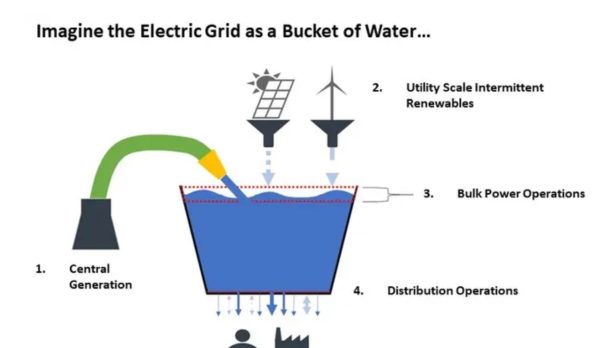The structure of our energy grid hasn’t changed much since the 20th century. What are we missing out on?
When we flip a switch, plug in a device, or turn on our electric stove, we often don’t think about the distance our electricity traveled to get to us. Despite the critical role our energy grid plays in our everyday lives, it often goes unnoticed- that is until it fails.
In February 2021, Texas experienced a major winter storm that caused an electricity generation failure. According to CNBC, 25 individuals died and over 4.1 million people lost power. This tragedy has brought attention to our national energy grid- or lack thereof.
The US national energy grid is not a singular grid, but in fact a number of regional grids, or Regional Transmission Pools (RTOs), that are loosely connected. As described by the U. S. Energy Information Administration, each RTO functions as its own energy grid, managing the manufacturing of energy sources, generating the energy, transmitting the electricity, and monitoring itself.

Each RTO essentially holds a monopoly on electrical energy in its own region, and this model has worked flawlessly in the early 20th century when electricity was just being introduced to American homes. In a Vox article, David Roberts, a climate science writer, explains why monopolies worked so well initially by identifying two main factors: “extremely high barriers to entry” and “enormous economies of scale”. “Extremely high barriers to entry” refers to the large sums of money required to build a power plant or establish high voltage transmission lines, and “enormous economies of scale” refers to how the cost to deliver energy only got cheaper as the size of the grid increased. Robert describes how these two factors, together, would lead to a “natural monopoly”, or a monopoly where it’s the most efficient for a single provider to exist.

However, in the 21st century, this model has many drawbacks. As stated by David Roberts, “The entire system is run by monopoly utilities with little incentive to innovate.” Consequently, our energy grids still live in the 20th century, when we need them to operate in the 21th century, with an ever growing amount of renewable energy sources, changing energy demands, and consumers that are now able to produce their own energy.
In fact, in a summary report conducted by a team of researchers at Energy Innovation, they found that switching from our current RTO system to a system that makes utilities to compete for consumers only in the southeast region of the USA would: create 285,000 jobs in the energy by 2024, decrease carbon emissions from the energy sector by approximately 37% relative to 2018 by 2024, and save approximately 384 billion dollars as expensive gas and coal plants are replaced by cheaper hydro dams, wind turbines, and solar farms.

By continuing to operate under RTOs, our grids are slower to implement information and communication technology(or ICT for short). As defined by the Information Technology Industry Council, ICT refers to “the communications networks that connect all parts of the grid including operations, service providers, customers, distribution, and transmission by facilitating communications between machines, between humans, and between humans and machines”. In simpler words, ICT helps the parts in our energy grid communicate with each other, communication that is currently very slow and may have to be done manually in certain areas.

ICT has already been largely implemented in the US, with over 75% of homes having smart sensors, found in a report by Smart Energy International in 2020. Smart meters detect the amount of voltage a house is using and report that amount to utilities. Smart sensors also double to report any blackouts or brownouts (basically a temporary blackout) to utility companies. However, we have yet to come anywhere close to taking advantage of its full potential.

Currently, the outdated 20th century grid is built so that energy transfers one way, from the producer to the consumer. Connecting additional sources of electricity to the grid is a hassle, however this can no longer be the case. With ICT, connections would be easier to make.
Alongside this, although there have been many projects to establish solar, wind, and other renewable energy farms, connecting and asking for energy is complicated. Normally with coal and gas plants, we request a certain amount of voltage from the plant, however the output of wind and solar farms varies wildly depending on the weather. As a result, we have to adapt, and ICT can help with this.
To summarize:
- Our current energy grid has the same structure it did in the 20th century.
- Our current energy grid is made up of IROs that hold a monopoly on energy in their area.
- Monopolies do not reward innovation, so our current energy grids have not been trying to implement new tech such as information and communication technology.
- Information and communication technology has many benefits that we are missing out on because of our current structure.
So what should we do now? We know the problem and the solution, but there lies a greater problem with trying to implement the solution. As mentioned earlier, they have little incentive to innovate and improve their energy grid when they can continue to make a profit functioning as they are.
Honestly, there is no easy way to go about this. This is a common problem with climate change solutions. The set of actions we need to reach a goal is clear, however motivating larger businesses, especially IROs that already hold a monopoly, will always prove to be difficult.
However, not all hope is lost. Many groups like the Information Technology Industry Council will continue to push for more efficient and advanced technology for our energy grid. There really is no other option, as temperatures rise and severe weather events continue to hit the country, more and more people, like senators after the 2021 Texas power crisis, will recognize that we need to modernize the grid.









